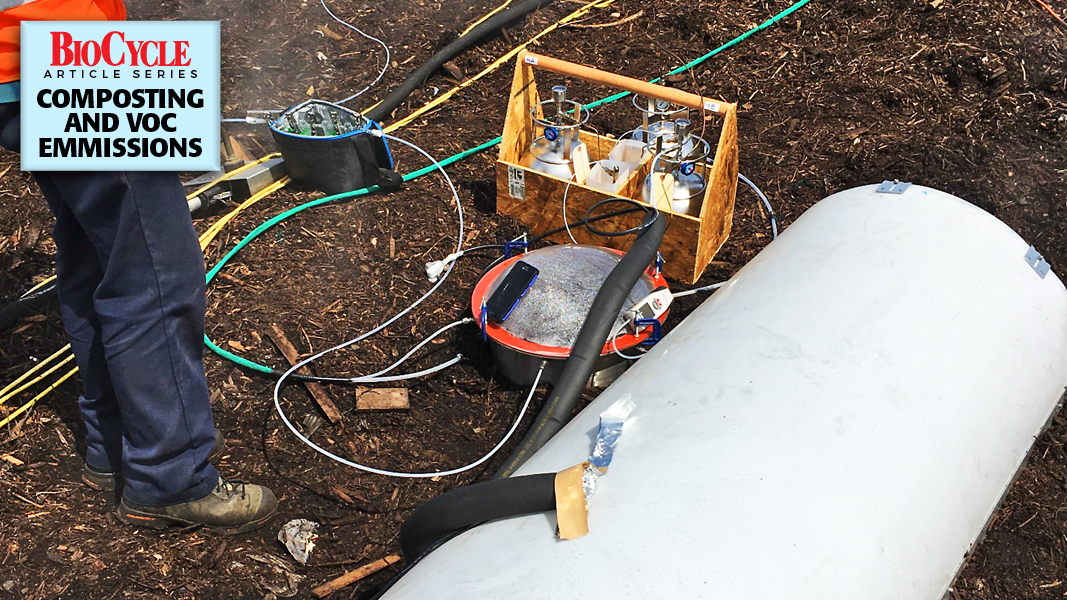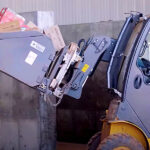Sally Brown, Andrew Carpenter and Lauren Souther
Top photo: Large sampling hood (right) being tested side by side with a standard 25.3 flux chamber (adjacent to hood). Photo courtesy of Engineered Compost Systems
Parts I and II of this Composting And VOC Emissions series covered what composting VOCs (volatile organic compounds) are, how are they measured, and regulatory requirements to control them. Constraints with the measurement tools and the regulations, e.g., use of default emission factors, were discussed. Part III focuses on opportunities to improve on all fronts.
Improvements fall into three general categories. First, in the existing structure, modifications to current testing requirements would likely make monitoring less expensive. Second, there is the potential to make regulations based on updated default factors more reflective of existing emissions from facilities with an emphasis on quantifying the efficacy of control technologies. Finally, there is also the goal of finding a silver bullet (or multiple ones): Cost-effective means to accurately quantify VOC emissions from composting. Let’s look at the potential for each of these.
Modifications To Existing Structure
While not quite silver bullets, there are modifications to the South Coast (CA) Air Quality Management District’s (SCAQMD) methods available that would: 1) Generate two samples rather than three from each sampling point by eliminating the need for a condensate trap (by heating the sample line); and 2) Analyzing the contents of the SUMMA canister as a single sample. Additionally, some air emissions studies have used larger sample hoods in an attempt to capture variations across a pile. While larger, these hoods still represent only a small fraction of total pile size. The goal of these larger hoods is to potentially reduce the number of samples required and reduce costs. Side by side comparisons with existing methods have not been conducted.
We interviewed a source testing company that conducts emissions testing for composting facilities across the West who noted that depending on where in California they are sampling, they are sometimes allowed to modify the flux chamber method or use a different method all together. If the flux chamber is used without the cold trap and the sample is heated, the sample can be analyzed as a single phase rather than as a two-part sample. These types of minor modifications would result in some cost savings.
Another option would be to use default factors that include consideration of improved process control technologies. If the database that forms the basis for these default factors is expanded, it is more likely to be reflective of actual emissions from modern day operations. If the database also includes information on the effectiveness of process conditions (aeration rate, average temperatures, oxygen levels, etc.) and control treatments such as biofilters and surface irrigation, this would likely be a way to both comply with the need for emissions regulations and reduce roadblocks to permitting additional composting capacity.
The California Air Resources Board (CARB) has an equation for estimating emissions that includes a consideration of the efficiencies of controls (EF=Emission Factors):
Total Annual Emissions = (CPEF x (1-CE) x TP) + (SEF x SD X TP)
Where:
CPEF = Composting Process EF in lbs/wet ton
SEF = Stockpile EF in lbs/wet ton/day
SD = Average number of days material is stockpiled
CE = Percent Control Efficiency
TP = Total annual facility throughput in wet tons (California ARB, 2015)
If something like this is used with a robust and current data set behind it, there is an excellent chance that both composters and the environment would benefit.
New And Improved
There are a few emerging technologies that might enable simplified or more accurate measures of VOC emissions from composting. Hand-held FIDs or PIDs (flame ionization or photoionization detectors) rather than sending samples to a laboratory for analysis are one option. However, in the two cases we found of side-by-side comparisons of NMNEOC (non-methane, non-ethane organic compounds) and ammonia between hand-held devices and the SCAQMD methods, no correlations between results were found.
One technology with some promise is the electronic nose (e-nose). The device is typically placed above a compost pile (indirect sample) and sensors within the device can offer real-time monitoring of emissions over time. Here time is defined as multiple samples per minute across weeks. E-noses have been used in the peer reviewed literature much more extensively than in real life. Typically, real life applications are for odor monitoring and conflict resolution between facilities and their neighbors, rather than VOC and ammonia measurement. At the present time, e-nose technology would not represent a cost savings.
On the futuristic end of things, there are some newer technologies to measure emissions indirectly with a relatively high degree of precision, but they are not yet commonly used and can be very expensive. One example is the Proton Transfer Reaction Time of Flight Mass Spectrometry (PTR-TOF-MS) method. Equipment is located in a van with a “snorkel” on top. The van is driven around the emissions source while its equipment quantifies VOCs and reports results every second. A flux can be generated if a meteorological station is set up at the source.
The second newer technology is the micrometeorological mass balance (MMB) method, wherein towers are set up around an emissions source, and they measure emissions with cavity ring-down spectrometers. The towers also have instruments to measure wind speed and direction attached to them. The total emissions from a source are calculated as the difference between upwind and downwind emissions.
Public/Private Collaboration
If the end goal is to divert organics from landfills to compost piles, it would make sense to streamline regulatory requirements for composting, including those for VOC monitoring. We would encourage regulators to work with academics, source testing companies and composters to develop reasonable practices for both controlling and monitoring emissions. If emission factors are used instead of sampling, the development of a new standard table of emissions factors based on multiple studies and multiple sampling events from operating facilities would provide a much more robust basis for regulations.
A future dataset, generated from many operating facilities, could also be used to develop a better understanding of emissions based on feedstocks, local climate and operating parameters. These could then be used to further refine either sampling requirements or emission factors. Additional research could be conducted to confirm field results.
Another alternative could be using a combination of best management practices (BMPs) and emission factors. Process conditions have a large effect on emissions from composting. If regulators focused on setting standards for BMPs and process conditions, and if emission factors were updated to accurately reflect emissions under different management practices, the combination could be more effective at diverting organic waste from landfills and reducing emissions of VOCs and ammonia in a way that is both practical and cost-effective. In this piece we’ve talked about comparing apples to oranges. Let’s not lose sight of all the benefits associated with composting (protect the orchard as a whole) rather than splitting hairs over some potentially rotten fruit.
Sally Brown, BioCycle’s Senior Adviser and long-time Connections columnist, is a Research Professor at the College of the Environment at the University of Washington. Andrew Carpenter is a certified soil scientist, certified crop advisor and certified nutrient management planning specialist. He founded Northern Tilth, an environmental consulting firm focusing on organic waste management and building soil health, in 2003 and has been recycling organic matter-based by-products since 1992. Lauren Souther is a research scientist and nutrient management planning specialist at Northern Tilth. She received a BS in Wildlife Biology from Unity College in 2017.
Authors’ Note: This article series is based on a report developed for the Composting Council Research and Education Foundation (CCREF) and funded with donations from the composting industry.













